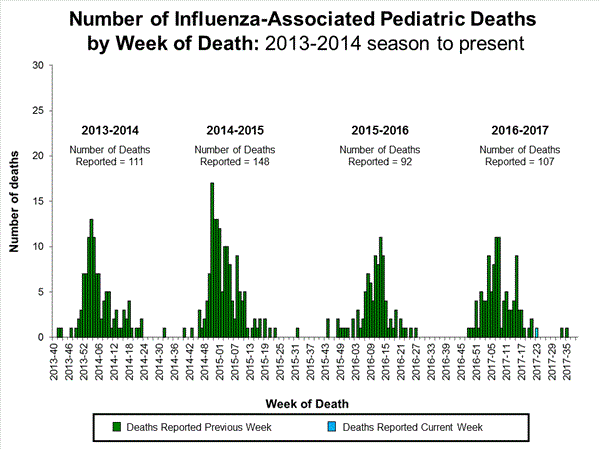
2016-2017 Influenza Season Week 39 ending September 30, 2017
All data are preliminary and may change as more reports are received.
U.S. Virologic Surveillance:
WHO and NREVSS collaborating laboratories, which include both public health and clinical laboratories located in all 50 states, Puerto Rico, and the District of Columbia, report to CDC the total number of respiratory specimens tested for influenza and the number positive for influenza by virus type. In addition, public health laboratories also report the influenza A subtype (H1 or H3) and influenza B lineage information for the viruses they test and the age or age group of the persons from whom the specimens were collected. Additional virologic data can be found at: http://gis.cdc.gov/grasp/fluview/fluportaldashboard.html and http://gis.cdc.gov/grasp/fluview/flu_by_age_virus.html.
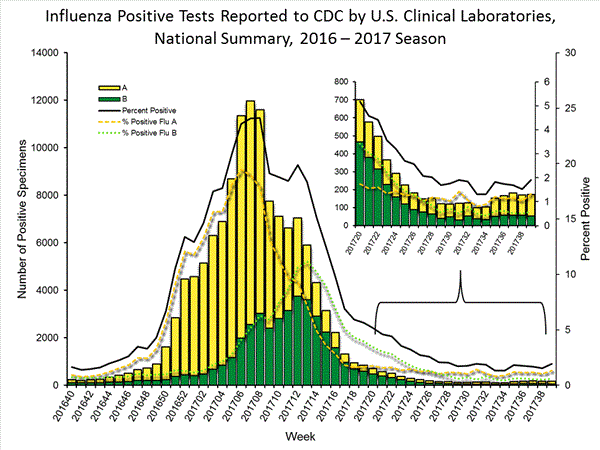
View National and Regional Level Graphs and Data | View Chart Data | View Full Screen | View PowerPoint Presentation
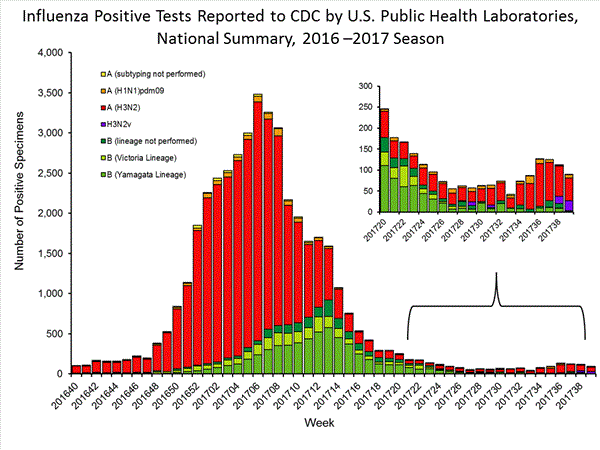
View National and Regional Level Graphs and Data | View Chart Data | View Full Screen | View PowerPoint Presentation
An outbreak of influenza A(H3N2) variant (H3N2v) virus infections in Maryland was first reported to the state health department on September 18, 2017. Although the number of reported human cases in Maryland is declining, an additional 8 human infections associated with this ongoing investigation were reported to CDC. In addition, Michigan reported a single H3N2v case, unrelated to the ongoing investigation in Maryland (Maryland [8] and Michigan [1]). Six of these viruses have been confirmed as H3N2v viruses; the remaining three viruses have tested presumptive positive for H3N2v at the Maryland public health laboratory; further testing is being performed by CDC to characterize these viruses. All nine patients reported exposure to swine at one of two agricultural fairs during the week preceding illness onset. Swine influenza A(H3N2) viruses were identified from respiratory samples collected from pigs at one of the fairs. Eight of the nine patients were children younger than 18 years and one patient was an adult aged >50 years. One of the nine patients was hospitalized and all patients are recovering or have fully recovered from their illness. No human-to-human transmission of these viruses has been identified.
With the addition of the nine cases reported for this week, a total of 61 variant virus infections have been reported to CDC in the United States during 2017. Fifty-six of these were H3N2v viruses (Delaware [1], Maryland [36], Michigan [1], North Dakota [1], Ohio [15], Pennsylvania [1], and Texas [1]) and two were influenza A (H1N2) variant (H1N2v) viruses (Ohio [2]). An additional three viruses have tested presumptive positive for H3N2v and further analysis is being conducted at CDC (Maryland [3]).
Early identification and investigation of human infections with novel influenza A viruses are critical to ensure timely risk assessment and so that appropriate public health measures can be taken. Additional information on influenza in swine, variant influenza infection in humans, and strategies to interact safely with swine can be found at http://www.cy118119.com/flu/swineflu/index.htm.
Pneumonia and Influenza (P&I) Mortality Surveillance:
Based on National Center for Health Statistics (NCHS) mortality surveillance data available on October 5, 2017, 5.4% of the deaths occurring during the week ending September 16, 2017 (week 37) were due to P&I. This percentage is below the epidemic threshold of 6.0% for week 37
Background: Weekly mortality surveillance data include a combination of machine coded and manually coded causes of death collected from death certificates. There is a backlog of data requiring manual coding within NCHS mortality surveillance data. The percentages of deaths due to P&I are higher among manually coded records than more rapidly available machine coded records and may result in initially reported P&I percentages that are lower than percentages calculated from final data. Efforts continue to reduce and monitor the number of records awaiting manual coding.
Beginning in the week ending October 8, 2016 (week 40), CDC retired the 122 Cities Mortality Reporting System and uses only the NCHS Mortality Surveillance System.
Region and state-specific data are available at http://gis.cdc.gov/grasp/fluview/mortality.html.
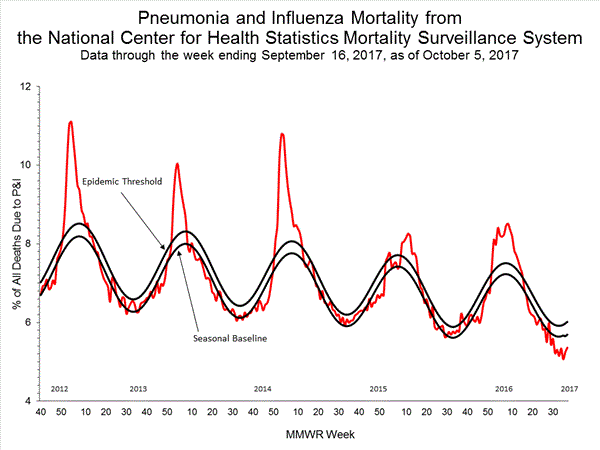
View Regional and State Level Data | View Chart Data | View Full Screen | View PowerPoint Presentation
Influenza-Associated Pediatric Mortality:
One influenza-associated pediatric death was reported to CDC during week 39. This death was associated with an influenza A virus for which no subtyping was performed and occurred during week 23 (the week ending June 10, 2017). A total of 107 influenza-associated pediatric deaths have been reported for the 2016-2017 season.
Additional data can be found at: http://gis.cdc.gov/GRASP/Fluview/PedFluDeath.html.Influenza-Associated Hospitalizations:
The Influenza Hospitalization Surveillance Network (FluSurv-NET) conducts all age population-based surveillance for laboratory-confirmed influenza-related hospitalizations in select counties in the Emerging Infections Program (EIP) states and Influenza Hospitalization Surveillance Project (IHSP) states. FluSurv-NET data can be found at: http://gis.cdc.gov/GRASP/Fluview/FluHospRates.html and http://gis.cdc.gov/grasp/fluview/FluHospChars.html.
Outpatient Illness Surveillance:
Nationwide during week 39, 1.2% of patient visits reported through the U.S. Outpatient Influenza-like Illness Surveillance Network (ILINet) were due to influenza-like illness (ILI). This percentage is below the national baseline of 2.2%. (ILI is defined as fever (temperature of 100擄F [37.8擄C] or greater) and cough and/or sore throat.)
Additional data are available at http://gis.cdc.gov/grasp/fluview/fluportaldashboard.html.
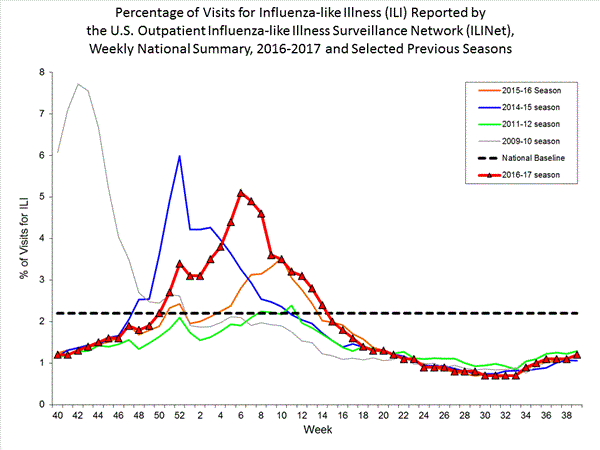
View National and Regional Level Graphs and Data | View Chart Data | View Full Screen | View PowerPoint Presentation
Additional National and International Influenza Surveillance Information
FluView Interactive: FluView includes enhanced web-based interactive applications that can provide dynamic visuals of the influenza data collected and analyzed by CDC. These FluView Interactive applications allow people to create customized, visual interpretations of influenza data, as well as make comparisons across flu seasons, regions, age groups and a variety of other demographics. To access these tools, visit http://www.cy118119.com/flu/weekly/fluviewinteractive.htm.
U.S. State and local influenza surveillance: Click on a jurisdiction below to access the latest local influenza information.
World Health Organization: Additional influenza surveillance information from participating WHO member nations is available through FluNet and the Global Epidemiology Reports.
WHO Collaborating Centers for Influenza located in Australia, China, Japan, the United Kingdom, and the United States (CDC in Atlanta, Georgia).
Europe: For the most recent influenza surveillance information from Europe, please see WHO/Europe and the European Centre for Disease Prevention and Control at http://www.flunewseurope.org/.
Public Health Agency of Canada: The most up-to-date influenza information from Canada is available at http://www.phac-aspc.gc.ca/fluwatch/
Public Health England: The most up-to-date influenza information from the United Kingdom is available at https://www.gov.uk/government/statistics/weekly-national-flu-reports
Any links provided to non-Federal organizations are provided solely as a service to our users. These links do not constitute an endorsement of these organizations or their programs by CDC or the Federal Government, and none should be inferred. CDC is not responsible for the content of the individual organization web pages found at these links.
An overview of the CDC influenza surveillance system, including methodology and detailed descriptions of each data component, is available at: http://www.cy118119.com/flu/weekly/overview.htm.
--------------------------------------------------------------------------------